Saint Mary MacKillop Feast Day 2020
August 8, 2020Greetings on the feast of Saint Mary MacKillop.
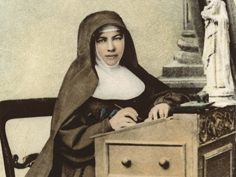
Celebrating the feast of Mary MacKillop in 2020 will be different for many of us. During these past months people across the world have been dealing with the reality and impact of the coronavirus. For many places where devotion to Saint Mary MacKillop has grown, this year’s celebration of her life will be different. With limited attendance in churches, the celebration of Eucharist for many will be through live stream. With pilgrimage sites not accessible for people, we need once again to draw upon our creativity and find different ways to mark this special day in the life of the church. What encouragement might Mary MacKillop offer us at this time in the life of the world. In 1907 she wrote to the Sisters:
Mary MacKillop is with us. Her own experience of life leads us to be in deep communion with her as we celebrate. We remember that Mary herself suffered from ill-health. She is close to all those whose health has been impacted by the COVID-19. She was close to death on a few occasions and found comfort in those who shared these times with her. She writes:
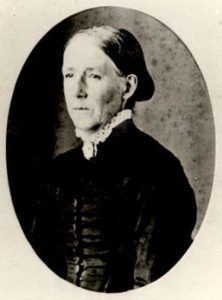
Mary MacKillop also knew the pain of loss and grief in her life. Mary felt deeply the loss of each member of her family. Perhaps her greatest loss was that of her mother Flora who was drowned in a shipwreck off the coast of Eden in New South Wales. At this time, she writes to her brother Donald:
For those who are losing their jobs and finding themselves unemployed, Mary MacKillop also knows what this experience is like. Her father was not able to hold down a permanent job leaving the family constantly on the move and placing extra stress on family life. It was this that caused Mary to find work at Sands and Kenny to support the family.
The opening prayer of the Liturgy for her feast says: “Holy God, source of all goodness, you show us in Mary MacKillop a woman of faith who lived by the power of the cross.” On this feast day let us be mindful that Mary MacKillop stands at the cross with us encouraging us to keep alive the flame of hope, bringing solace to those who have lost loved ones or employment, and comforting those whose lives have been changed for ever through the COVID-19 pandemic. For Mary MacKillop the Cross became the Tree of Life. Walking in and through the Cross she drew strength from the God who loved her. Mary MacKillop embraced the suffering in her life and shows us how to persevere in the face of adversity. We take to heart her message:
On this feast, ‘may we share in her courage, see with her vision, and love with her heart.’
May Mary MacKillop’s deep love for you be your gift this day.
Sr Monica Cavanagh
Congregational Leader
You’re invited to view a video titled ‘Celebrating the feast of Saint Mary MacKillop’ below:
Mass will be live streamed from the Mary MacKillop Memorial Chapel, North Sydney at 10:00am AEST on her feast day (Saturday 8 August 2020). Please find the link provided below:
Feast Day Mass live streamed from Mary MacKillop Memorial Chapel
Footnotes:
[1] Lesley O’Brien, Mary MacKillop Unveiled, p. 145
[2] Mary MacKillop 17 June 1886
Media Release: National Vocations Awareness Week
August 2, 2020Drawing on the wisdom of Saint Mary MacKillop through National Vocations Awareness Week (2-9 August 2020).
Each year the Church celebrates National Vocations Awareness Week. This week is dedicated to promoting the various expressions of Christian vocation with a focus on promoting priesthood and consecrated life.
This year, a group of Josephite Sisters and Affiliates have been asked to contribute video content about their Ministries and how they participate in God’s mission today.
“The response has been extremely pleasing, and we are thrilled to showcase the great works of these individuals,” said Kathleen Norman, Communications Manager, Sisters of Saint Joseph. “The first of the content series will be launched on Sunday 2 August in time for the start of National Vocations Awareness Week, and then continue throughout the remainder of this year.”
Drawing from reflection on Saint Mary MacKillop’s experience, Sister Monica added: “My advice to young Australians of faith is – be the voice of the gospel and the face of God in the world today. Be courageous; use your passion and energy to address the critical issues facing the world and church today.”
During these unusual times throughout the COVID-19 pandemic, research shows us there is a new openness to the sharing of faith in 2020. Australians have turned to prayer during the coronavirus with many wanting to spend more time growing their faith once restrictions are lifted.
The Sisters of Saint Joseph believe that Saint Mary MacKillop would offer encouragement during these difficult times. In 1907 she wrote to the Sisters:
Sr Monica Cavanagh, Congregational Leader, believes strongly that Mary MacKillop is with us:
Saint Mary MacKillop herself wrote about her testing experience of being dangerously unwell:
I was for many weeks dangerously ill, so ill that I nearly died… I was weary of the world and its crosses… The mental conflict had been too much for me.
Please continue reading the Media Release here (PDF)
For more information, please contact:
Kathleen Norman
Communications Manager
Sisters of Saint Joseph
Kathleen.Norman@sosj.org.au
+61 2 8912 2722 +61 438 006 566
Celebrate Mary’s Feast Day with Mary MacKillop Today
July 30, 2020Provided below is a message from Mary MacKillop Today to schools about the feast of Mary MacKillop on 8 August 2020.
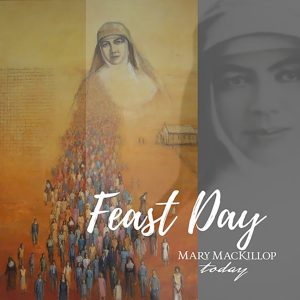 Mary MacKillop’s Feast Day is coming up in August.
Mary MacKillop’s Feast Day is coming up in August.
This year is particularly special because it is the 10 year anniversary since Mary was canonised as Australia’s first Saint. Education was close to Mary’s heart and she knew its power to lift communities out of poverty. This is why Mary MacKillop Today is asking schools across Australia to celebrate Mary’s Feast Day with us and raise funds to help give children in Fiji access to early education!
Throughout August, we’re inviting schools to hold their own fundraising activities and set a target of $1,500 (or more!). That’s enough to give a vulnerable community in Fiji the resources they need to build a safe and effective learning environment for eager children.
Once your school is registered, Mary MacKillop Today will provide resources to help your school promote and run a successful fundraiser.
Click the link below to register for your school’s resources today and celebrate Mary MacKillop’s legacy by helping transform lives with the gift of education:
Mary MacKillop Feast Day fundraising activities
If you have any questions, please don’t hesitate to contact Madeleine Gough, Mary MacKillop Today’s Community Partnerships Coordinator, directly via email madeleine.gough@marymackilloptoday.org.au or telephone on (02) 8912 2708
Nine Days With Mary MacKillop Novena
July 29, 2020These nine days will offer an opportunity to pray and reflect on scripture, Mary MacKillop and your own lives, all within your own time.
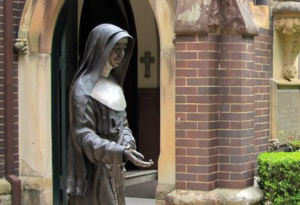 Friday 31 July marks the beginning of our Novena – a time when we can reflect on how the Scriptures, Mary MacKillop’s life and our life intertwine to encourage us in all that we do.
Friday 31 July marks the beginning of our Novena – a time when we can reflect on how the Scriptures, Mary MacKillop’s life and our life intertwine to encourage us in all that we do.
As this Novena is online – you might like to form a group or two to share in this retreat together.
Thank you for praying together as we look forward to celebrating the feast day of Saint Mary MacKillop (Saturday 8 August).
Day One, 31 July: Opening To Our Potter God
- Day One: YouTube version (compatible with all devices)
- Day One: PDF version (suitable for iPad, Android and PC users)
- Day One: PowerPoint version (best suited for those using a PC)
Day Two, 1 August: Becoming Good Soil
- Day Two: YouTube version (compatible with all devices)
- Day Two: PDF version (suitable for iPad, Android and PC users)
- Day Two: PowerPoint version (best suited for those using a PC)
Day Three, 2 August: Becoming Light for the World
- Day Three: YouTube version (compatible with all devices)
- Day Three: PDF version (suitable for iPad, Android and PC users)
- Day Three: PowerPoint version (best suited for those using a PC)
Day Four, 3 August: Becoming Salt for the Earth
- Day Four: YouTube version (compatible with all devices)
- Day Four: PDF version (suitable for iPad, Android and PC users)
- Day Four: PowerPoint version (best suited for those using a PC)
Day Five, 4 August: Encountering God
- Day Five: YouTube version (compatible with all devices)
- Day Five: PDF version (suitable for iPad, Android and PC users)
- Day Five: PowerPoint version (best suited for those using a PC)
Day Six, 5 August: Loving Tenderly
- Day Six: YouTube version (compatible with all devices)
- Day Six: PDF version (suitable for iPad, Android and PC users)
- Day Six: PowerPoint version (best suited for those using a PC)
Day Seven, 6 August: Acting Justly
- Day Seven: YouTube version (compatible with all devices)
- Day Seven: PDF version (suitable for iPad, Android and PC users)
- Day Seven: PowerPoint version (best suited for those using a PC)
Day Eight, 7 August: Walking Humbly
- Day Eight: YouTube version (compatible with all devices)
- Day Eight: PDF version (suitable for iPad, Android and PC users)
- Day Eight: PowerPoint version (best suited for those using a PC)
Day Nine, 8 August: Feast Day
- Day Nine: YouTube version (compatible with all devices)
- Day Nine: PDF version (suitable for iPad, Android and PC users)
- Day Nine: PowerPoint version (best suited for those using a PC)
So Small a Beginning: Part 4
July 8, 2020Sr Marie Foale speaks about the beginnings of the Institute of St Joseph for the Catholic education of poor children.
She believes that as a young Josephite growing up, she had a sense that one day Mary MacKillop and Julian Tenison Woods had made a spontaneous decision to found an order.
Reflection on Mary MacKillop
Mary MacKillop Continues to Make a Difference.
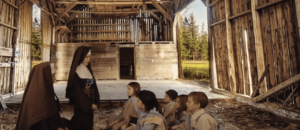
By the end of 1882 we had a foundation in the south coast of New South Wales, Albion Park. Archbishop Vaughan asked us to take over St. John’s School in Kent Street, Sydney. The people were very poor around Kent St, which was ‘a scene of much human misery’. Every day one of the Sisters cooked a substantial meal for the children and a hot drink was ready for them when they arrived at school. Even on Sundays the sisters cooked breakfast for the children and their parents. Our sisters truly were servants for the poor.
Extract from ‘The Letter under the Pillow‘ by Clare Aherne (2016) Chapter 11, pp. 59-60. Carrowmore Publishing Ltd, Ireland.
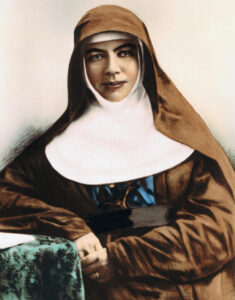
Mary MacKillop was a woman who championed the rights and needs of the poor in the community. Mary and the early sisters worked exceedingly hard to make a difference to the lives of the deprived. It seems remarkable that the sisters were able to provide such sustenance and assistance when they too relied on Providence. No doubt they sought out donations and went begging for food to enable this marvellous ministry to the poor.
Mary and the Sisters also knew suffering and death.
Let us reflect…
- What feelings well up in you when you think of Mary’s generosity in these early days?
- The present COVID-19 crisis paints a grim picture of hardship, sickness and death in the community.
What has affected your life during this time?
Have you been able to help others cope with endure their plight? - Are we able to extend kindness to our neighbours of all cultures?
Let us pray.
Michele Shipperley rsj
Image:
[1] The Story of Mary MacKillop a short film by Holy Family Primary, Granville. Obtained from Cath Family.
Reflection on Mary MacKillop
June 8, 2020In 1873-1874 Mary travelled from Rome and then to London where the McDougalls invited her to stay at their house in Clapham Park and make herself at home during their absence. Mary then travelled to Paris and to her ancestral home the Braes of Lochaber in Scotland.
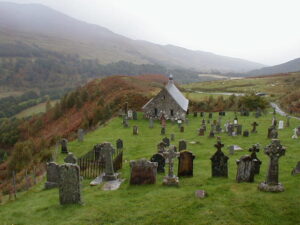
From there she returned to Fort William, where illness delayed her again for a few days before she could start for Fort Augustus. She was overjoyed to meet on the canal steamer the priest who had consoled her in her loneliness at Versailles. He paid her expenses and handed her over to her relative, Dean MacDonald of Fort Augustus, with whom she then stayed for three days. The story was the same everywhere – helpful priests and kindly welcomes in convents. … Fr Bissett gave her soul ‘the help and encouragement it sometimes so sadly needed.’
Extract from ‘Mary MacKillop: An Extraordinary Australian’ by Paul Gardiner sj (1993) pp. 140-141. E J Dwyer Pty Ltd Australia.
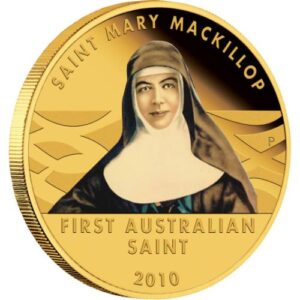
Let us ponder on Mary’s life during the long wait to hear from Rome about the future of the congregation.
- Imagine Mary’s delight and relief on meeting her relatives and visiting her ancestral home.
- What are your thoughts about Mary’s choice to move from comfort to cheap and convenient lodgings?
- How does Mary’s humour, devotion and resilience speak to you in this vingnette?
Mary MacKillop Saint for Australia and the world, pray for us.
Michele Shipperley rsj
Image sources:
[1] Cille Choirille Church and Graveyard by Dave Fergusson obtained from Wikimedia Commons. .
[2] Saint Mary MacKillop commemorative coin obtained from The Perth Mint Australia website.
So Small a Beginning: Part 3
Sr Marie Foale speaks about the beginnings of the Institute of St Joseph for the Catholic education of poor children.
She believes that as a young Josephite growing up, she had a sense that one day Mary MacKillop and Julian Tenison Woods had made a spontaneous decision to found an order.
